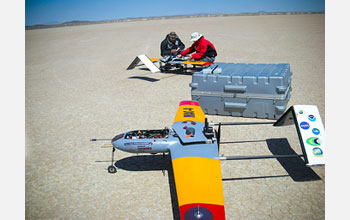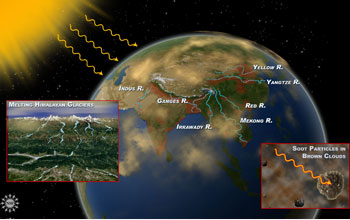All Images
News Release 08-082
Finding Answers in the Clouds
Unmanned drones show how air pollution can impact weather, climate and global warming
This material is available primarily for archival purposes. Telephone numbers or other contact information may be out of date; please see current contact information at media contacts.

V. Ramanathan, chief scientist of the Maldives Campaign, accompanied by several autonomous unmanned aerial vehicles.
Credit: Scripps Institution of Oceanography, UC San Diego
Download the high-resolution JPG version of the image. (871 KB)
Use your mouse to right-click (Mac users may need to Ctrl-click) the link above and choose the option that will save the file or target to your computer.
Scientists have long understood that air pollution can impact the formation of clouds and the broader climate. Recent research by a team from the Scripps Institution of Oceanography using unmanned aerial vehicles provides new insights into how air pollution can impact the atmosphere's albedo, or rate of sunlight reflection. The research has implications for our understanding of climate change. V. Ramanathan, a professor at Scripps and the lead researcher for the project, describes the research and its findings.
Credit: National Science Foundation

A AUAV involved in the Maldives project. The aircraft can stay airborne for hours, travel hundreds of miles and fly at 15,000 feet in altitude.
Credit: Scripps Institution of Oceanography, UC San Diego
Download the high-resolution JPG version of the image. (164 KB)
Use your mouse to right-click (Mac users may need to Ctrl-click) the link above and choose the option that will save the file or target to your computer.

Members of the Scripps team make adjustments to the AUAVs. Built by Advanced Ceramics Research of Tucson, Ariz., these AUAVs carry miniaturized instrument packages developed by members of Ramanathan's team, including Greg Roberts, M V Ramana and Craig Corrigan. These instruments are capable of measuring solar radiation, cloud-drop size and concentrations, particle size and concentrations, turbulence, humidity and temperature.
Credit: Scripps Institution of Oceanography, UC San Diego
Download the high-resolution JPG version of the image. (316 KB)
Use your mouse to right-click (Mac users may need to Ctrl-click) the link above and choose the option that will save the file or target to your computer.

Ramanathan and his colleagues want to better understand how pollution alters the earth's albedo, or amount of sunlight that is reflected back out into space. Albedo impacts the earth's temperature, weather patterns and the broader climate, and has been linked to global warming.
Credit: Nicolle Rager Fuller, National Science Foundation
Download the high-resolution JPG version of the image. (465 KB)
Use your mouse to right-click (Mac users may need to Ctrl-click) the link above and choose the option that will save the file or target to your computer.
